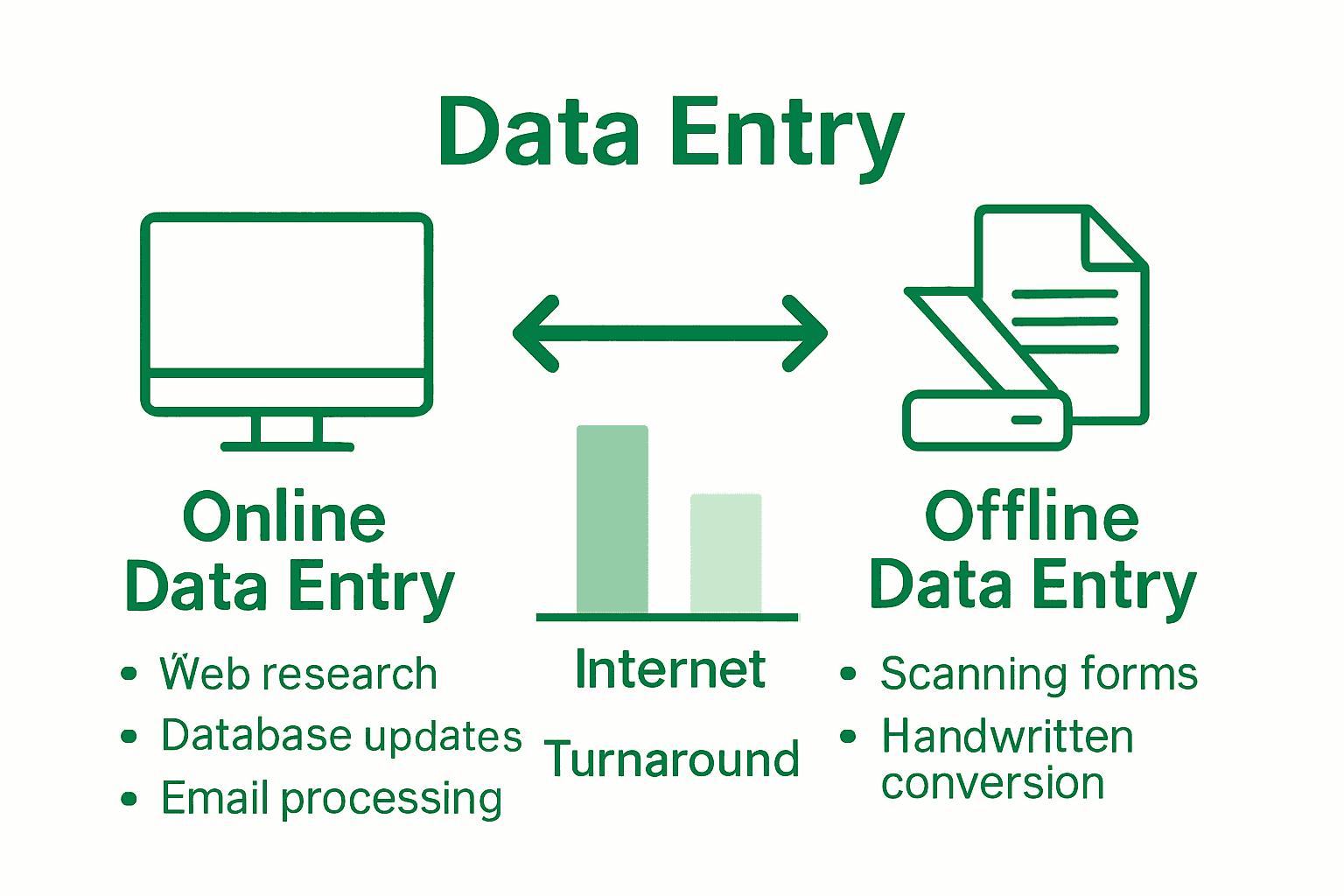Over 80 percent of companies now outsource at least some of their data entry tasks. Managing business information takes up valuable time and resources, often leading to mistakes or missed opportunities when handled in-house. Outsourcing data entry gives organizations a smarter way to handle growing volumes of data while cutting costs and boosting accuracy. This guide breaks down what data entry outsourcing really means and how it can transform your business operations.
What Is Data Entry Outsourcing?
Data entry outsourcing is a strategic business practice where companies delegate data management tasks to external professionals or service providers. At its core, data entry outsourcing involves hiring specialized teams or individual contractors to input, process, organize, and maintain digital information across various platforms and systems.
The primary objective of data entry outsourcing is to streamline administrative workflows by transferring time-consuming data handling responsibilities to skilled professionals. Organizations leverage this approach to reduce operational costs, improve data accuracy, and free up internal resources for more strategic business activities. As highlighted in recent research from academic sources like understanding outsourcing benefits for companies, external data management can significantly enhance organizational efficiency.
Typical data entry outsourcing tasks encompass a wide range of activities, including:
- Digital document conversion
- Spreadsheet population and management
- Database updating and maintenance
- Online form filling
- Customer information processing
- Inventory record management
- Survey and research data compilation
By partnering with specialized external teams, businesses can access professional expertise without maintaining full-time, in-house data entry staff. This model offers remarkable flexibility, allowing companies to scale data management resources up or down based on current project requirements. The approach is particularly beneficial for organizations dealing with large volumes of data or those seeking to optimize administrative processes while maintaining high standards of accuracy and efficiency.
Major Types of Data Entry Outsourcing
Data entry outsourcing can be broadly categorized into two primary types: online data entry and offline data entry. These classifications help businesses understand the diverse range of services available and select the most appropriate solution for their specific organizational needs.
Here’s a comparison of online vs. offline data entry outsourcing types:
| Aspect | Online Data Entry | Offline Data Entry |
|---|---|---|
| Internet Requirement | Required | Not required |
| Typical Tasks | Web research Database updates Email processing | Scanning forms Handwritten text conversion Archive management |
| Main Tools Used | Web platforms Cloud software | Scanners Manual data entry tools |
| Turnaround Flexibility | High, real-time updates | Moderate, based on document access |
| Data Source Type | Digital-only | Physical and paper-based |
| Use Case Example | Online retail catalog updates | Paper survey digitization |

Online Data Entry involves digital tasks that require internet connectivity and specialized digital skills. In this category, professionals handle activities such as:
- Website data compilation
- Online catalog updates
- Digital database management
- Web research and data extraction
- Social media data tracking
- Email and contact information processing
Offline Data Entry focuses on traditional document processing tasks that do not necessarily require constant internet connectivity. This type of outsourcing typically includes:
- Physical document scanning
- Paper form digitization
- Handwritten record conversion
- Image-to-text data translation
- Manual spreadsheet population
- Archive document management
Beyond these primary categories, companies can also explore specialized data entry outsourcing models like outsource repetitive tasks for seamless efficiency. These models enable businesses to customize their data management approach based on specific project requirements, complexity of tasks, and desired level of external support.
How the Data Entry Outsourcing Process Works
The data entry outsourcing process is a structured approach that transforms raw information into organized, digital assets through a systematic collaboration between businesses and external service providers. Data management workflow typically follows a carefully designed sequence of steps to ensure accuracy, efficiency, and seamless information transfer.
The process generally unfolds through several critical stages:
- Initial Consultation and Requirement Assessment
- Identifying specific data entry needs
- Defining project scope and complexity
- Establishing data security and confidentiality protocols
- Determining required turnaround times
- Data Preparation and Screening
- Organizing source documents
- Categorizing information types
- Preparing digital templates
- Ensuring data quality and consistency standards
- Data Processing and Entry
- Skilled professionals input information using specialized software
- Cross-verification of entered data
- Implementing quality control mechanisms
- Managing data transformation and digitization
- Quality Assurance and Validation
- Multiple-stage error checking
- Automated and manual verification processes
- Ensuring complete data accuracy
- Resolving any discrepancies or inconsistencies

Businesses looking to optimize their back-office operations can benefit significantly from understanding these intricate processes. As part of a comprehensive approach to operational efficiency, how to outsource back office processes can provide additional insights into streamlining administrative tasks and reducing organizational overhead.
Successful data entry outsourcing hinges on establishing clear communication channels, defining precise expectations, and maintaining robust quality control mechanisms. By partnering with experienced service providers, organizations can transform complex data management challenges into streamlined, cost-effective solutions that enhance overall operational productivity.
Benefits and Value for Modern Businesses
Data entry outsourcing delivers substantial strategic advantages for modern businesses seeking to optimize their operational efficiency and technological capabilities. Organizational transformation through external data management represents a critical approach to streamlining administrative processes and allocating internal resources more strategically.
Key benefits of data entry outsourcing include:
- Cost Reduction: Eliminating expenses associated with full-time data entry staff
- Enhanced Productivity: Freeing internal teams to focus on core business activities
- Access to Specialized Expertise: Leveraging professional skills and advanced technological tools
- Scalability: Rapidly adjusting data management capabilities based on organizational needs
- 24/7 Operational Support: Continuous data processing across different time zones
- Improved Data Accuracy: Utilizing specialized professionals with refined data handling skills
Businesses can significantly improve their operational landscape by implementing strategic outsourcing models. key benefits of business process outsourcing provide deeper insights into how external partnerships can transform organizational performance and drive competitive advantage.
Moreover, data entry outsourcing enables companies to maintain technological agility in an increasingly complex digital environment. By partnering with experienced service providers, organizations can access cutting-edge data management technologies, sophisticated quality control mechanisms, and specialized expertise that would be prohibitively expensive to develop internally. This approach not only reduces operational costs but also creates a flexible, responsive framework for managing increasingly complex information ecosystems.
Risks, Costs, and Key Considerations
Data entry outsourcing presents a complex landscape of potential benefits and inherent risks that organizations must carefully navigate. Strategic risk management becomes paramount when considering external data processing partnerships, requiring comprehensive assessment of financial, operational, and security implications.
Key risks and potential challenges include:
- Data Security Vulnerabilities
- Potential exposure of sensitive organizational information
- Risk of unauthorized data access or breaches
- Compliance challenges with data protection regulations
- Quality Control Concerns
- Inconsistent data entry accuracy
- Limited direct oversight of processing methods
- Potential communication barriers with external teams
- Hidden Cost Considerations
- Initial integration and training expenses
- Potential technology compatibility investments
- Ongoing management and coordination overhead
Financial implications demand meticulous evaluation. While outsourcing can generate significant cost savings, businesses must conduct thorough cost-benefit analyses that account for both direct and indirect expenses. 7 essential outsourcing best practices can provide critical guidance in developing a robust outsourcing strategy that minimizes potential risks.
Successful data entry outsourcing hinges on establishing robust vendor selection criteria, implementing rigorous security protocols, and maintaining transparent communication channels. Organizations should prioritize service providers with proven track records, advanced security certifications, and demonstrated expertise in handling sensitive data across diverse industry landscapes. Comprehensive due diligence, including detailed contract negotiations and periodic performance evaluations, remains essential in transforming potential risks into manageable, strategic partnerships.
Unlock Seamless Efficiency with Expert Data Entry Outsourcing
Managing vast amounts of data can be overwhelming and fraught with risks such as data security vulnerabilities and costly errors. If you are aiming to reduce operational costs, improve data accuracy, and gain scalable data management solutions, the path is clear. Data entry outsourcing lets you shift time-consuming tasks to skilled professionals, empowering your internal teams to focus on strategic growth instead of repetitive workloads.
Experience the freedom of reliable external support that understands your unique challenges such as quality control concerns, integration complexities, and turnaround demands. NineArchs LLC offers tailored outsourcing solutions designed to deliver professionalism, cost-efficiency, and scalability while safeguarding your data with rigorous security protocols.

Ready to transform your data management and back-office operations? Discover how NineArchs can help you navigate the complexities of data entry outsourcing with proven expertise and customized support. Connect with us today at NineArchs Contact to start optimizing your business workflows and unlock your full potential now.
Frequently Asked Questions
What is data entry outsourcing?
Data entry outsourcing involves hiring external professionals or service providers to manage data input, processing, and organization. This strategic approach aims to enhance efficiency, cut costs, and improve data accuracy for businesses.
What types of tasks are typically included in data entry outsourcing?
Common tasks in data entry outsourcing include digital document conversion, database maintenance, online form filling, customer information processing, and inventory record management.
What are the benefits of outsourcing data entry services?
Outsourcing data entry can lead to cost reductions, increased productivity, access to specialized expertise, improved data accuracy, and scalable data management solutions tailored to organizational needs.
What are the risks associated with data entry outsourcing?
Risks include potential data security vulnerabilities, quality control issues, and unforeseen costs. Businesses must conduct thorough assessments and establish clear protocols to mitigate these risks.









